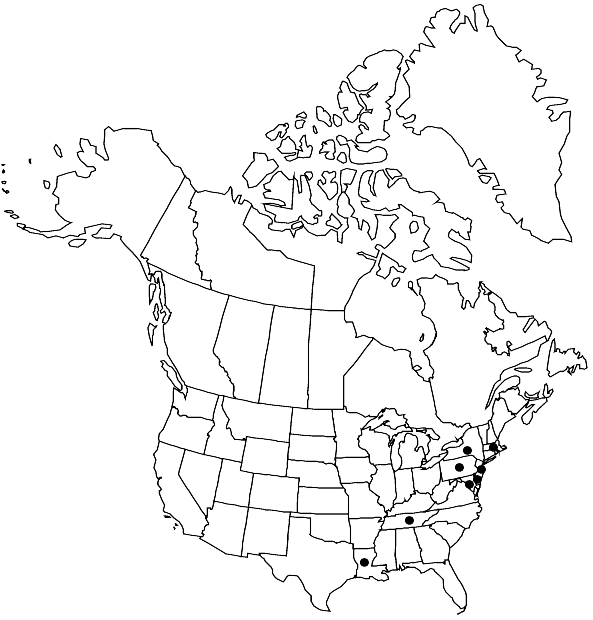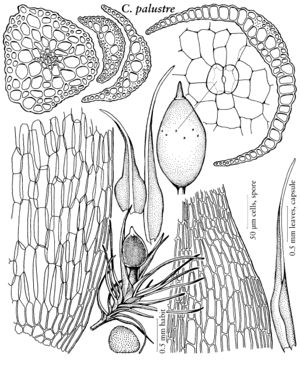Difference between revisions of "Cleistocarpidium palustre"
Fragm. Florist. Geobot. 41: 1035. 1996,.
FNA>Volume Importer |
FNA>Volume Importer |
||
| Line 13: | Line 13: | ||
|name=Astomum palustre | |name=Astomum palustre | ||
|authority=(Bruch & Schimper) Hampe | |authority=(Bruch & Schimper) Hampe | ||
| − | }}{{Treatment/ID/Synonym | + | }} {{Treatment/ID/Synonym |
|name=Bruchia palustris | |name=Bruchia palustris | ||
|authority=(Bruch & Schimper) Müller Hal. | |authority=(Bruch & Schimper) Müller Hal. | ||
| − | }}{{Treatment/ID/Synonym | + | }} {{Treatment/ID/Synonym |
|name=Pleuridium palustre | |name=Pleuridium palustre | ||
|authority=(Bruch & Schimper) Bruch & Schimper | |authority=(Bruch & Schimper) Bruch & Schimper | ||
| − | }}{{Treatment/ID/Synonym | + | }} {{Treatment/ID/Synonym |
|name=Sporledera palustris | |name=Sporledera palustris | ||
|authority=(Bruch & Schimper) Schimper | |authority=(Bruch & Schimper) Schimper | ||
| Line 37: | Line 37: | ||
|elevation=low to moderate elevations | |elevation=low to moderate elevations | ||
|distribution=Del.;La.;Md.;Mass.;N.J.;N.Y.;Pa.;Tenn.;Europe. | |distribution=Del.;La.;Md.;Mass.;N.J.;N.Y.;Pa.;Tenn.;Europe. | ||
| − | |discussion=<p>The chromosome number is n = 7 (H. A. Crum and L. E. Anderson 1981). Cleistocarpidium palustre (can be recognized easily by the extremely long subula, which is flexuose to some degree, the excurrent costa, and the characteristic capsule, small rostrum, and mitrate calyptra. In transverse sections of the leaf, the two largest guide cells are at the center of the costa. Although an annulus is absent in the capsule of C. palustre, a non-functional rudimentary ring is present in the rostrum beyond the spore sac region in C. japonicum (Deguchi, Matsui & Z. Iwatsuki) K. L. Yip, which distinguishes these two taxa. The latter species was initially recognized as the former (S. Risse 1991) because of the similar gametophytes.</p> | + | |discussion=<p>The chromosome number is n = 7 (H. A. Crum and L. E. Anderson 1981). <i>Cleistocarpidium palustre</i> (can be recognized easily by the extremely long subula, which is flexuose to some degree, the excurrent costa, and the characteristic capsule, small rostrum, and mitrate calyptra. In transverse sections of the leaf, the two largest guide cells are at the center of the costa. Although an annulus is absent in the capsule of <i>C. palustre</i>, a non-functional rudimentary ring is present in the rostrum beyond the spore sac region in C. japonicum (Deguchi, Matsui & Z. Iwatsuki) K. L. Yip, which distinguishes these two taxa. The latter species was initially recognized as the former (S. Risse 1991) because of the similar gametophytes.</p> |
|tables= | |tables= | ||
|references= | |references= | ||
| Line 61: | Line 61: | ||
|publication year= | |publication year= | ||
|special status= | |special status= | ||
| − | |source xml=https://jpend@bitbucket.org/aafc-mbb/fna-data-curation.git/src/ | + | |source xml=https://jpend@bitbucket.org/aafc-mbb/fna-data-curation.git/src/8f726806613d60c220dc4493de13607dd3150896/coarse_grained_fna_xml/V27/V27_669.xml |
|genus=Cleistocarpidium | |genus=Cleistocarpidium | ||
|species=Cleistocarpidium palustre | |species=Cleistocarpidium palustre | ||
Revision as of 16:56, 18 September 2019
Plants very small. Sexual condition paroicous (and reportedly autoicous). Seta stout, pale, 0.6–1 mm, erect. Capsule immersed, ovoid, broadest at the base, whitish, not glossy, spore sac orange, 1–1.5 × 0.6–0.8 mm, strongly apiculate, stomatose in proximal half. Calyptra covering the apiculus, mitrate, shallowly 4-lobed to cucullate, deeply split on one side.
Phenology: Capsules mature early summer (May–Jun).
Habitat: Wet soil, sandy swamps
Elevation: low to moderate elevations
Distribution

Del., La., Md., Mass., N.J., N.Y., Pa., Tenn., Europe.
Discussion
The chromosome number is n = 7 (H. A. Crum and L. E. Anderson 1981). Cleistocarpidium palustre (can be recognized easily by the extremely long subula, which is flexuose to some degree, the excurrent costa, and the characteristic capsule, small rostrum, and mitrate calyptra. In transverse sections of the leaf, the two largest guide cells are at the center of the costa. Although an annulus is absent in the capsule of C. palustre, a non-functional rudimentary ring is present in the rostrum beyond the spore sac region in C. japonicum (Deguchi, Matsui & Z. Iwatsuki) K. L. Yip, which distinguishes these two taxa. The latter species was initially recognized as the former (S. Risse 1991) because of the similar gametophytes.
Selected References
None.
